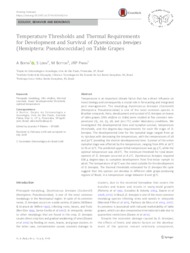Temperature thresholds and thermal requirements for development and survival of dysmicoccus brevipes (Hemiptera: Pseudococcidae) on table grapes.
Temperature thresholds and thermal requirements for development and survival of dysmicoccus brevipes (Hemiptera: Pseudococcidae) on table grapes.
Author(s): BERTIN, A.; LERIN, S.; BOTTON, M.; PARRA, J. R. P.
Summary: Temperature is an important climate factor that has a direct influence on insect biology and consequently a crucial role in forecasting and integrated pest management. The mealybug Dysmicoccus brevipes (Cockerell) (Hemiptera: Pseudococcidae) is one of the most common species in Brazilian vineyards. Here, development and survival of D . brevipes on leaves of table grapes ( Vitis vinifera cv. Itália) were studied at five constant tem- peratures (15, 20, 25, 28, and 30 ± 1°C) under laboratory conditions. We investigated the developmental time and nymphal survival, temperature thresholds, and the degree-day requirements for each life stage of D . brevipes . The developmental time for the nymphal stage ranged from 32 to 130 days with decreasing the temperature, with the temperatures of 28 and 30°C providing the shorter developmental time. Survival of the entire nymphal stage was affected by the temperature, ranging from 81% at 20°C to 1% at 15°C. The predicted upper lethal temperature was 34.5°C, while the optimal temperature was 28.6°C. The minimum threshold for total devel- opment of D . brevipes occurred at 8.2°C. Dysmicoccus brevipes required 678.4 degree-days to complete development from first-instar nymph to adult. The temperature of 30°C was the most suitable for the development of D . brevipes. The thermal thresholds estimated for D . brevipes life cycle suggest that this species can develop in different table grape-producing regions of Brazil, in a temperature range between 8 and 35°C.
Publication year: 2018
Types of publication: Journal article
Unit: Embrapa Grape & Wine
Observation
Some of Embrapa's publications are published as ePub files. To read them, use or download one of the following free software options to your computer or mobile device. Android: Google Play Books; IOS: iBooks; Windows and Linux: Calibre.
Access other publications
Access the Agricultural Research Database (BDPA) to consult Embrapa's full library collection and records.
Visit Embrapa Bookstore to purchase books and other publications sold by Embrapa.

